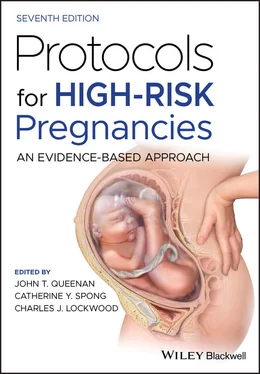The purpose of this chapter is to review specific genetic conditions for which carrier screening is most commonly offered. We review the clinical significance, cause, and screening recommendations for each condition.
Cystic fibrosis
Clinical significance
Cystic fibrosis is a progressive disease that has severe effects on the pulmonary, pancreatic, hepatic, and gastrointestinal systems. The majority of males with cystic fibrosis also have primary infertility due to absence of the bilateral vas deferens. The median predicted survival is 42 years of age. The incidence is 1 in 2500 among Caucasian individuals but significantly lower in other populations. The carrier rates are approximately 1 in 25 for Ashkenazi Jewish and Caucasian populations, 1 in 60 for Hispanics and African Americans, and 1 in 94 for those of Asian ancestry.
Cystic fibrosis is caused by autosomal recessive inheritance of a mutation of the CFTR gene. CFTR is responsible for production of proteins that aid in transmembrane transport of chloride and regulate the activity of other ion channels. Greater than 2000 CFTR mutations have been identified, although most of the mutations are exceptionally rare. Individuals with cystic fibrosis can be homozygotes or compound heterozygotes. Genotype can provide some insight into phenotype due to variable effects of these mutations on the chloride channel proteins.
Screening for cystic fibrosis should be offered to all women who are considering pregnancy or are currently pregnant. The sensitivity of screening varies significantly among individuals of different races and ethnicities given the variable carrier rate of different mutations. Detection rates range from 49% to 94% depending on the population being screened. Individuals should be counseled that a negative screen cannot completely rule out carrier status. The American College of Medical Genetics and Genomics (ACMG) recommends use of a panel that screens for the most common 23 or greater CFTR mutations. Expanded panels may minimally improve detection rate of carriers, particularly among those of Caucasian backgrounds. Additionally, CFTR sequencing may be useful for individuals with a family history of cystic fibrosis who have negative screening panels, although it is not recommended for routine carrier screening because variants of uncertain significance may be discovered and thus preclude practitioners’ ability to provide meaningful counseling.
Spinal muscular atrophy
Clinical significance
Spinal muscular atrophy is a disease that results in diffuse and progressive muscle atrophy. Its effects range widely from onset of severe muscle weakness in infancy and early death from respiratory failure to mild muscle weakness in adults with otherwise normal survival. There are several types of spinal muscular atrophy which are based on age at onset of symptoms. The phenotypes are characterized in order of severity from type 1 (most severe) to type 4 (least severe). Of genetic disorders, spinal muscular atrophy is relatively common, with an incidence of 1 in 8000 live births and a carrier rate of 1 in 35 to 1 in 117, depending on ethnicity. It is the most common cause of infant death by a monogenic etiology.
The SMN1 gene and, to a lesser extent, the SMN2 gene are responsible for the production of survival motor neuron proteins, which inhibit degradation of anterior horn cells and motor nuclei. Most cases of spinal muscular atrophy are caused by a deletion or mutation in SMN1 , found on chromosome 5, resulting in deficient protein production. In a noncarrier, there is typically one copy of SMN1 per chromosome, although rarely two copies can be present on the same chromosome. The number of copies of SMN2 per chromosome ranges from zero to three. In affected individuals, SMN2 copy number modifies the overall production of the protein, with a greater copy number corresponding to milder clinical phenotypes (types 3 and 4).
Screening for spinal muscular atrophy should be offered to all women who are considering pregnancy or are currently pregnant. Screening entails evaluation of the number of copies of SMN1, which is two in nonaffected noncarriers of spinal muscular atrophy. It is important to note that some individuals will have a chromosome with two copies and a chromosome with zero copies, which will be detected as a normal overall SMN1 copy number of two; these individuals are unaffected but can transmit a chromosome with zero copies of SMN1 to their offspring, who will thus be affected. Therefore, individuals should be counseled regarding the residual risk of carrier status despite a normal screening result. There is also a relatively high 2% de novo mutation rate of SMN1 that limits the ability to completely determine risk of spinal muscular atrophy. Copy number of SMN2 is generally not tested as part of carrier screening (and therefore, carrier screening cannot predict phenotype) but is used for prognostic purposes in the setting of diagnostic testing.
For individuals with a family history of spinal muscular atrophy, reports of genetic testing of the affected individual and carrier testing of the parent should be reviewed to determine residual risk in the setting of a negative screen. If reports are unavailable, testing should instead be offered to the low‐risk partner.
Hemoglobinopathies
Clinical significance
Hemoglobinopathies can be divided into sickle cell disorders and thalassemias.
Sickle cell disorders lead to vasoocclusion, pain, and infarcts in vital organs including the spleen, kidneys, heart, lungs, and brain. Hemoglobin S, the most common variant hemoglobin leading to sickle cell disease, is carried by approximately 1 in 10 African Americans but fewer than 1 in 100 Hispanics or non‐Hispanic whites or Asians.
Alpha‐thalassemia minor causes mild anemia, hemoglobin H disease causes hemolytic anemia with splenomegaly and iron overload, and alpha‐thalassemia major (hemoglobin Bart disease) causes hydrops fetalis with intrauterine fetal demise. Alpha‐thalassemia is more common among individuals of African, Mediterranean, Middle Eastern, and Southeast Asian backgrounds, with carrier status among these groups ranging from 1 in 3 to 1 in 30.
Beta‐thalassemia minor causes mild anemia, while beta‐thalassemia major causes severe anemia and poor growth, resulting in childhood death in the absence of treatment. Beta‐thalassemia is more common among those with Mediterranean, Middle Eastern, Asian, and Indian ancestry and has a carrier frequency as low as 1 in 8 among certain populations.
Hemoglobin A, the normal adult form of hemoglobin, is comprised of two alpha and two beta globin chains. Sickle cell disorders are due to an abnormal combination of hemoglobin structural variants including S, C, or E, or one of these variants coupled with a thalassemic mutation. Such variant sickle cell hemoglobins are produced by single nucleotide alterations in the beta globin chain. Alpha‐thalassemia is due to deletion of two (alpha‐thalassemia minor), three (hemoglobin H disease), or four (alpha‐thalassemia major or hemoglobin Barts) of the four copies of the alpha globin gene which results in decreased or absent production. Notably, a cis‐mutation of alpha globin, defined as deletion of both alpha globin copies on the same chromosome, is more common among those of Southeast Asian background and is more likely to result in hemoglobin H disease or alpha‐thalassemia major. In contrast, a transmutation where a single deletion is found on each chromosome (more common among those of African American race) is less likely to result in a fetus with alpha‐thalassemia major. Beta‐thalassemia minor occurs among heterozygotes with a beta globin gene mutation resulting in deficient production; beta‐thalassemia major is due to homozygosity or compound heterozygosity of a mutated beta globin gene that causes decreased to absent production.
Читать дальше












